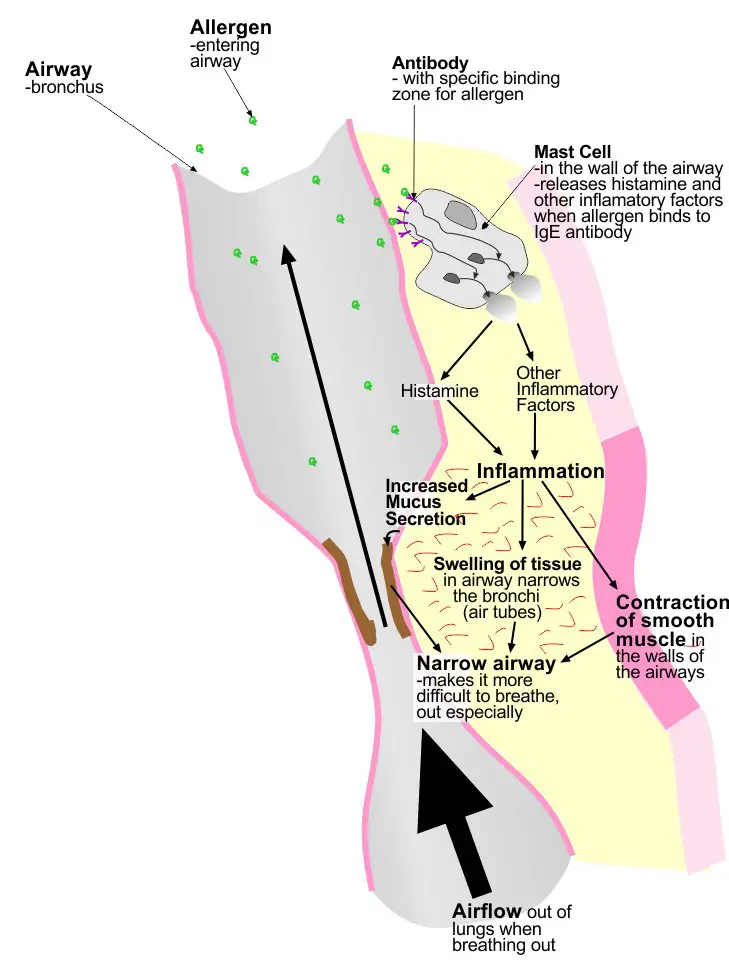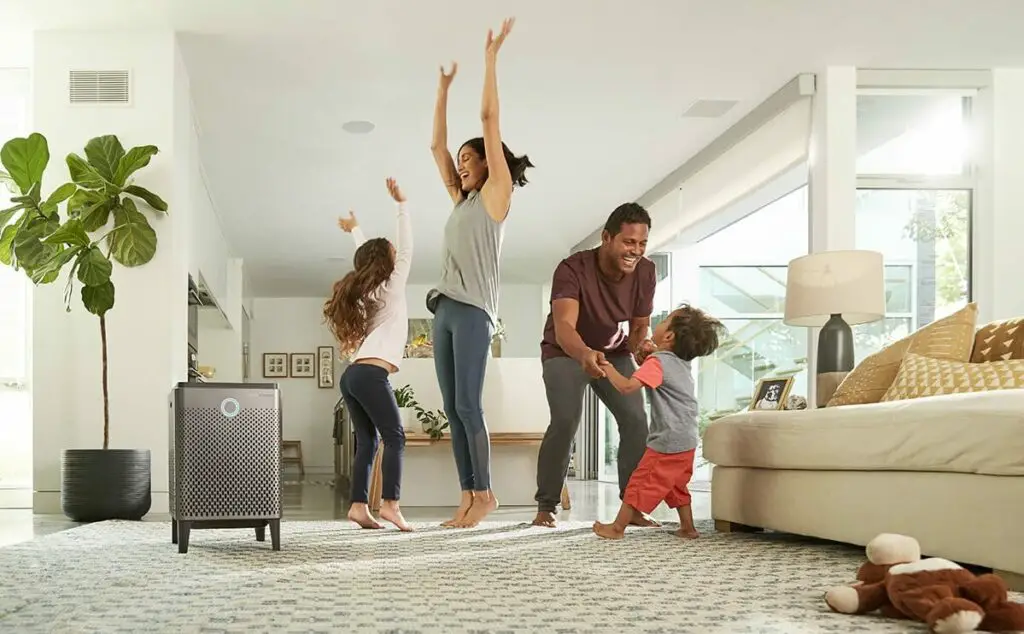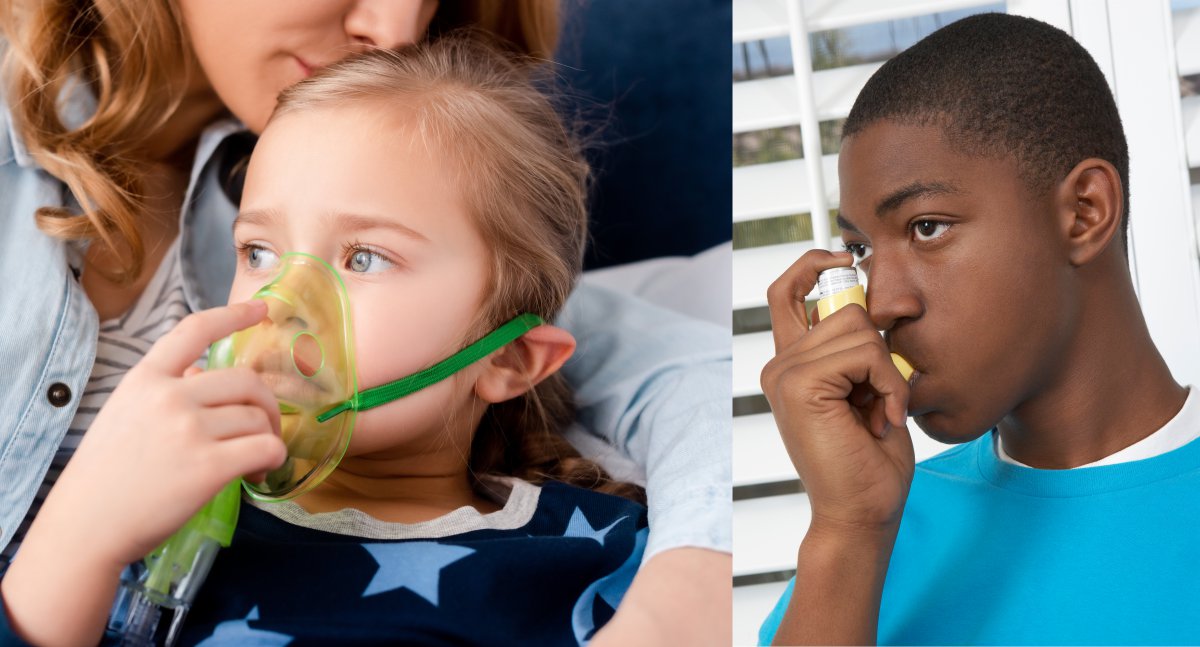Allergies occur when the immune system in tissues is exposed to a molecule usually a protein, that it has antibodies for. This interacting protein is called an “allergen”. The interaction of the allergen with the antibody then causes the release of chemicals which leads to inflammation. A typical example of this is when airborne allergens are inhaled and settle on the lining of a person’s airways. It can then interact with IgE antibodies on the surface of mast cells, leading to the release of histamine and other inflammatory factors which cause a person’s airways to become inflamed and make breathing more difficult. This is the basis for allergic asthma, but it can also cause problems in COPD. A similar reaction occurs in the nose in the case of allergic rhinitis.
The best air purifier for allergies is the iQair HealthPro Plus, it has the highest filtration specification of any air purifier on the domestic market. However, it may not suit you for various reasons.
I outline the pros and cons below.
The basic mechanism of allergy is shown in this diagram below –

Air Purifiers Are Effective in Reducing Symptoms of Airways Obstruction
A recent study showed that of 183 patients with chronic obstructive pulmonary disease (COPD) approximately 80% were exposed to one or more allergens. These allergens were from house dust mite, cockroach, cat, dog or mouse. IGE blood tests showed that 17% were sensitized to at least one allergen.
Exposure to an allergen and sensitization to it were associated with 8% lower lung function, worse respiratory scores and 2.3 fold risk for exacerbations. An “exacerbation” is where for a period, breathing becomes much more difficult and this can lead to hospital admission. Pet dander and cockroach both caused these effects, but interestingly house dust mite did not, although it was the most common allergen.
So allergen exposure can make a considerable difference to quality of life in patients with airways disease.
In another study 116 patients with COPD were randomized to six months use of in-home air cleaners. These had true HEPA filters as well as carbon filters or alternatively sham filters. Quality of life and exacerbations of their COPD were measured. There were 68% fewer moderate exacerbations in the group with real air filters as opposed to the sham air filters in their air purifiers. Also, in individuals who use the air purifiers for at least 80% of the time, as they were meant to, quality of life was also better.
So these studies suggest that exposure to airborne allergen in indoor air is important in determining respiratory symptoms in COPD and that air purifiers are effective in reducing symptoms from COPD. They do not directly prove that the improvement in airways function was due to the reduction of allergen it could have been due to the reduction of other particles. Nonetheless, a 70% reduction in exacerbations of COPD by the air purifiers was approximately similar to the best inhaler medication, so the effect of air purifiers was impressive.
This clearly shows that air quality matters. However, it should be emphasised that properly purified air should be breathed for at least 80% of the time and if possible more.
This is not to suggest that an air purifier should be used instead of inhaler medication, but simply that one may be a useful addition to inhaler medication and is worth considering in anyone with obstructive airways disease.
Size of Allergens and Implications for Which is the Best Air Purifier For Allergies
Allergies occur when a large molecule binds to an antibody and changes its physical characteristics. If the antibody is bound to a Mast cell, this cell will then release histamine and other inflammatory molecules which cause inflammation in the tissue. In the nasal passages, this leads to a runny nose and in the airways to wheezing and difficulty breathing-“asthma”.
As antibodies are large molecules, about 10nm in diameter, the allergen molecules that interact with them and change their shape usually need to have a fairly comparable size or be larger than the antibody (see table).
| Allergen | Diameter (nm) |
|---|---|
| Pollen | 1300-30,000 |
| House Dust Mite | >10 (main allergen faecal balls size 10,000-40,000) |
| Rat Urinary Antigen | 7 |
| Cat allergen Fel d 1 | 2-10 |
As Allergens Are so Small the Air Purifier Must Be Able to Remove Ultra-Ultrafine Particles
As you can see from the table, we need an air purifier that is specified to remove the smallest possible ultrafine particles, those less than 20nm in diameter. Whilst all HEPA air purifiers remove some ultrafine particles, even true HEPA filter performance tapers off for the smallest ultrafine particles.
There are only a few manufacturers that specify their air purifiers to remove particles of 10 nm or smaller. The manufacturer with the highest specification, that is, removing the smallest possible particles, is iQair. Their HyperHEPA filter is specified to remove 95% particles larger than 3 nm in diameter.
Most manufacturers have a pre-filter to protect the true HEPA filter and extended its lifespan. iQair has a pre-pre-filter option as well as a pre-filter which is in the same format as a normal true HEPA filter.
An Activated Carbon Filter Is Also a Benefit
It is possible to be allergic to chemicals in the form of gases, although almost invariably airborne particles are the cause. Gas molecules are not stopped by a particle filter which are designed to trap dust particles which are larger than molecules. Molecules will pass straight through the holes in a particle filter.
So although not nearly as important as the particle filter, it is an advantage to have an activated carbon filter. The activated carbon adsorbs the molecules by weak intermolecular bonds. Activated carbon filters are made more effective by adding other substances such as zeolite and oxidizing agent such as potassium permanganate. For further information please see this article, “The Best Air Purifier for Volatile Organic Compounds“.
Allergens are Usually Airborne Particles so the Lower the Allergen Count in the Air the Smaller the Allergic Reaction-so an air purifier with an adequate air cleaning rate is needed
The allergic reaction is determined by the amount of allergen exposure and also the reaction of the host. Different people will have different reactions to the same amount of allergen. At one of the end of the spectrum the person may not have any antibody to the allergen and so not be allergic, at the other end of the spectrum they may have an antibody which has a high affinity for the allergen as well as a sensitive to immune system which then amplifies the initial reaction. Somewhere in the middle, either the antibody may have a lower affinity for the allergen or the immune system may be less prone to amplify the response.
In any case, the amount of allergen exposure is important and we can reduce airborne allergen very effectively with air purifiers.
It is obviously crucial to have a filter that will remove the allergen and not just let it pass through, but once we have a filter the second crucial element is the amount of airflow through the filter relative to the size of the room.
The airflow through an air purifier/air cleaner for a true HEPA filter is usually almost exactly the same as the clean air delivery rate (CADR) as the filtration efficiency should be close to 100%-
CADR = filtration efficiency X airflow
However, you cannot assume this very occasionally a manufacturer quoted “airflow” will be without the filters in the machine! So you should look for the CADR when buying an air purifier. The EPA specifies CADR as the way of sizing the air purifier to the size of your room. However, some manufacturers do not specify it at all and many do not specify CADR for all fan speeds.
The importance of airflow is that the level of allergen decreases with increasing airflow. For instance if you meet the minimum EPA (Environmental Protection Agency) standard five air changes per hour (ACH) then the particle/allergen count will drop by 80%. An air change is defined as the volume of air in the room, going through the air cleaner once.
However in a real-world setting, even with an enormous airflow through an air purifier/cleaner it will be impossible to get the allergen count down to zero. This is because the rooms are not perfectly sealed, and when we move around in the room we agitate allergen that has dropped onto the floor back up into the air.
So why not have air purifiers that have a tremendously high airflow to lower particle count by 95%? This would work but in practice would be far too noisy to live with. So the sound that you will be able to tolerate for long periods will be a limiting factor. It may also decide which air purifier you feel is best for you. Of domestic air purifiers the Coway 400S and 300S have the highest airflow per decibel, so they will give you the highest airflow for whatever noise level you decide is suitable for you on a long-term basis. Of more industrial air purifiers, the SmartAir Blast Industrial will give even higher air flows per decibel, but the filter is currently not specified down to 10nm as the Coway and iQair are.
Features That Are Not Necessary
- Smart sensor-these are unnecessary and not an accurate enough a way of running an air purifier. Please see this article “Buying an Air Purifier“
- UV light-this does not help with allergens
Features That Are Not Essential and Should Not Sway a Buying Decision
Some features of an air purifier can be helpful, but are often associated with not having the best filters in it or sometimes any filters at all. So they should not sway the buying choice, here is a list of a few –
- Ionic mechanisms
- Plasmawave technology
- PECO technology
Again, this is all explained in more detail in this article – “Buying an Air Purifier“.
The Air Purifier Should Allow a Maximal Time For Breathing Purified Air-so it should be “smart”
To maximize the time for which purified air is breathed we will need a smart air purifier. One that can switch itself on at least half an hour before you step in the room. This is because all air purifiers take a while to lower the particle count in the room to as low as they can achieve. It depends upon room and air purifier size, but it will normally take 30-60 minutes. So you could have an extra 1-2 hours per day of breathing purified air by buying smart air purifiers.
Best Air Purifiers for Allergies
1) iQair HealthPro Plus (supreme particle filtration)-only suitable for room size up to 262 sq ft*
This air purifier has the highest filter specification of any machine for the domestic market and is truely medical grade. It is only suitable for rooms up to 262 sq ft, assuming the room has 8ft ceilings unless you are very tolerant of noise.
No pre-filter cleaning needed, this is quite an advantage as most air purifiers have pre-filters which should theoretically be cleaned every 2-4 weeks!

| Filters | |
| HEPA filter | HEPA specified to remove 99.8% of ultrafine particles down to a size of 0.003um |
| Carbon filter amount of carbon (lb) | 5 lb so 40x more than some other appliances |
| Filter Change HEPA (Particles) | 15 months for pre filter 48 months for Hyper-HEPA filter |
| Filter Change Carbon (Chemicals) | 20 months |
| Airflow | |
| CADR at =<50db (CADR on Maximum) | 170 cfm |
| Maximum Room Size (Noise less than 50db*) | 262 sq ft |
| Maximum Room Size (On noisiest setting) | 462 sq ft |
| Smart Control | Yes smart plug |
| Power | 74 W |
| Weight | 35 lbs |
| Dimensions “H x “W x D” | 28x 15 x 16 |
| Annual Running Cost Electricity ($) | $45 |
| Annual Running Cost Filters ($) | $180 |
| Total Annual Running Cost ($) | $230 |
In view of its supreme particle filtration this is the obvious choice for best air purifier for allergies.
There is a more extensive review of this air purifier “iQair HealthPro Plus“.
All the above are approximate and assume running the air purifier for 12 hours per day on the highest setting that keeps the noise below the level specified in db in the table. This is less than or equal to 50db in normal daytime use and 35db for bedrooms.
*Most people will not wish to have the air purifier on a setting louder than about 35db for sleeping in a bedroom-you may wish to have a quieter setting than 35db this is just a ballpark estimate for most people. On the other hand, if your room layout allows you to be much further than 6 feet from the air purifier you may find the noise this machine makes at top speed is alright. The calculations for room size assume that you have 8 foot ceilings and 5 air changes per hour.
Never run an air purifier on auto mode using the inbuilt sensor. These cannot detect ultrafine particles which are damaging to human health, please see this article- How to test the air quality in your home.
2) Coway 400S (suitable for large rooms and quiet)
This air purifier has a superb filter although with slightly lower specifications than the iQair. Its special feature is its high airflow with the lowest possible noise levels for the airflow.

| Filters | |
| HEPA filter | HEPA specified to remove 99.8% of ultrafine particles down to a size of 0.01um |
| Carbon filter amount of carbon (lb) | 1.5 lb so more than most other air purifiers |
| Filter Change HEPA (Particles) | 12 months |
| Filter Change Carbon (Chemicals) | 12 months |
| Airflow | |
| CADR at =<50db (CADR on Maximum) | |
| Maximum Room Size (Noise less than 50db*) | 450 sq ft |
| Maximum Room Size (On noisiest setting) | 640 sq ft |
| Smart Control | Yes phone app |
| Power | 66 W |
| Weight | 24.7 lbs |
| Dimensions “H x “W x D” | 22.8 x 14.8 x 14.8 |
| Annual Running Cost Electricity ($) | $40 |
| Annual Running Cost Filters ($) | $120 |
| Total Annual Running Cost ($) | $160 |
Conclusion
So the best air purifier for allergies is the iQair HealthPro plus for its excellent particle filtration. However, if you have a larger room or are very noise sensitive, then the Coway 400S is excellent and may suit you better.

